“The Wounded”
Written by Stuart Charno, Sara Charno, Cy Chermak, and Jeri Taylor
Directed by Chip Chalmers
Season 4, Episode 12
Production episode 40274-186
Original air date: January 28, 1991
Stardate: 44429.6
Captain’s Log: The Enterprise is on a mapping mission near the Cardassian border. A peace treaty signed a year earlier ended the long conflict between the Federation and the Cardassians, a conflict so vicious that there’s been nothing remotely resembling an indication of it in the past three-plus seasons’ worth of television episodes. Picard reminisces about a time he faced off against Cardassians while commanding the Stargazer.
A Cardassian ship, the Trager, attacks the Enterprise without obvious provocation. The Enterprise gets the upper hand in short order, at which point the Cardassian shipmaster, Gul Macet, is willing to talk. He reveals that a Federation starship destroyed a Cardassian science station in the Cuellar system. Picard assures Macet that the Federation has no wish to abandon the treaty. Macet tartly points out that the Cardassians haven’t abandoned it, but is willing to wait an hour while Picard contacts Starfleet.
Picard talks to Admiral Haden, who reveals that the U.S.S. Phoenix, under the command of Captain Benjamin Maxwell, one of Starfleet’s finest captains, destroyed the station. Picard assumes he must have had a reason for doing so, but Haden says he’s been on silent running, so they have no frapping clue what the heck he’s thinking. The Phoenix is still in Cardassian space, and Picard needs to find him and stop him. The Cardassians allow the Enterprise safe passage through their space in exchange for Macet and two of his aides coming on board as observers.
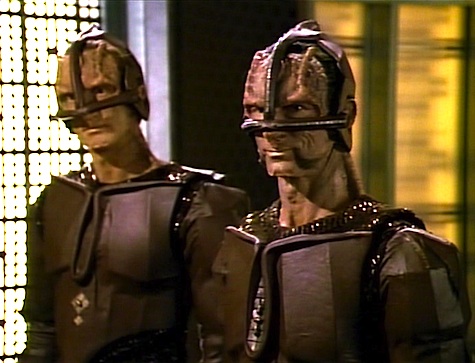
Haden also makes it clear that the Federation is in no shape for a sustained conflict right now, given the fleet’s losses at Wolf 359, and that Picard must maintain the peace at all costs.
O’Brien served with Maxwell on the Rutledge, so Picard invites him into a meeting with Macet. He reveals that Maxwell’s family was killed by Cardassian soldiers during an attack on an outpost on Setlik III. Macet assumes this to be revenge, but O’Brien disagrees.
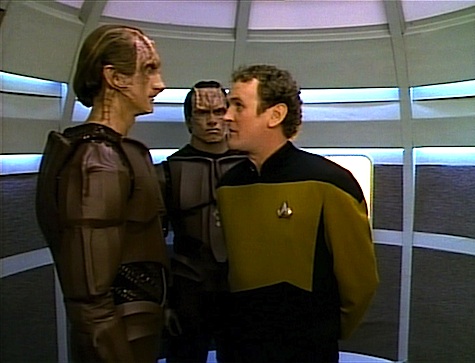
The Enterprise locates the Phoenix and sets a course. Macet tries to convince Picard to reveal their precise location and transponder code so a Cardassian ship can find them sooner rather than later, but Picard does not wish the situation to spiral out of control and declines to do so.
After refusing to drink with the Cardassians, and doing so rather obnoxiously, O’Brien goes to his quarters to prepare a potato casserole for Keiko. He sings “The Minstrel Boy,” a song he used to sing on the Rutledge while serving under Maxwell. He also insists to Keiko that he has no issue with the Cardassians, in direct contrast to the attitude he copped with them after they invited him to join them in Ten-Forward.
The Phoenix is going after a Cardassian supply ship. The Enterprise won’t get there in time, but there’s a warship nearby. Reluctantly, Picard orders Worf to supply the warship with, not only the Phoenix‘s transponder codes, but its prefix codes as well.
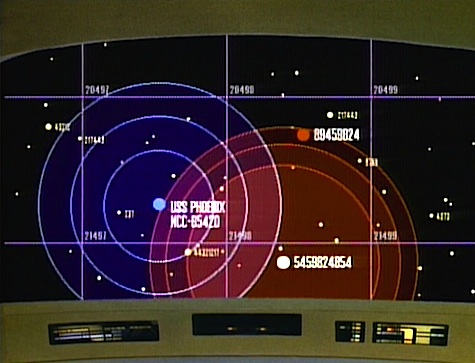
It winds up not helping, as the Phoenix destroys the warship and the supply ship. Picard inexplicably waits until after 650 Cardassians have been killed to increase to warp nine. Macet, for his part, is more than a little pissed.
Picard goes to talk to O’Brien, who sucks up (“I’ve served with the two finest captains in Starfleet”). O’Brien insists that Maxwell wouldn’t have attacked without reason, but Picard wonders if Maxwell’s anger at the Cardassians over the death of his family has become comfortable—”like old leather”—to the point where he doesn’t know how to feel any other way.
Later, O’Brien is in Ten-Forward, and decides to join Daro for that drink he offered, and apologizes for popping off at him. They talk about Setlik III. Daro says that it was a mistake: their intelligence was that it was a launching place for an attack on Cardassia. O’Brien reveals that it was on Setlik that he first killed anything, and that it isn’t the Cardassians he hates, it’s what he became because of the Cardassians.
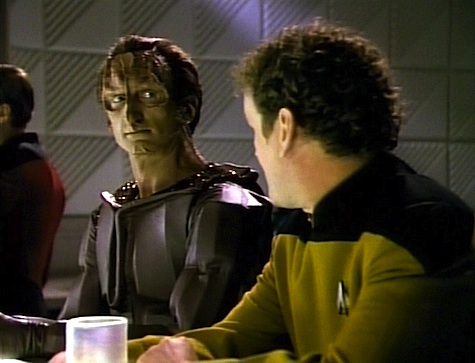
Worf brings Glinn Telle to the bridge: he was trying to access their weapons systems on a computer terminal, for which Macet upbraids him and confines him to quarters.
The Enterprise rendezvouses with the Phoenix, and Maxwell agrees to beam aboard. He and O’Brien have a brief reunion, where it’s revealed that O’Brien served at tactical on the Rutledge, then Riker escorts him to the captain’s ready room.
Maxwell informs Picard that the science station he destroyed was really a military supply outpost—but he’s weak on specifics. When Picard asks for documentation and proof, all Maxwell can come up with is that he could “smell” it. He says he didn’t report it because the bureaucrats would just sit on it for six months; they don’t know what it’s like to be under fire. Picard points out that Maxwell wasn’t under fire, and Maxwell tries some more clichés, each of which Picard has a response to. “Lives were at stake.” “Whose lives?” “We had to act now.” “Why?” “I took the initiative—I did what had to be done.” “What had to be done? For whom?”
Picard makes it clear that Maxwell’s attempts to trash the treaty are done. He will accompany the Enterprise back to Starbase 211. Picard allows him the dignity of retaining his command rather than throwing Maxwell in the brig and towing the Phoenix in disgrace.
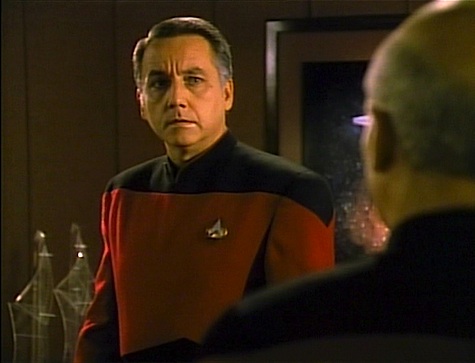
Maxwell responds to this courtesy by breaking formation and heading for a Cardassian vessel. The Enterprise pursues; at Riker’s suggestion, Picard brings O’Brien to the bridge, since he was once Maxwell’s tactical officer. The Phoenix intercepts the supply ship, but hasn’t fired yet. Data can’t read the supply ship, as it’s running with a subspace field that interferes with sensor readings.
Maxwell hails the Enterprise and insists that Picard board the ship, as it will have proof of Maxwell’s assertion that the Cardassians are re-arming. Picard refuses. Maxwell says that he’ll fire on the ship if Picard doesn’t board it; Picard counters that if Maxwell tries to do so, he’ll do whatever’s necessary to stop Maxwell.
O’Brien asks to talk to Maxwell directly. He manages to beam over and meets with Maxwell in his ready room. Maxwell asks what happened to this war, and O’Brien gently reminds him that the war’s over. But Maxwell insists that the Cardassians never stop making war, that they live for war, and refuses to accept O’Brien’s rational response that everyone thinks that about their enemy.
They reminisce about the Rutledge and wind up singing “The Minstrel Boy” together. Maxwell finally admits that he’s not going to win, and allows himself to be confined to guest quarters on the Enterprise.

Picard has one last conversation with Macet, revealing that Maxwell was right. The station he destroyed was a weapons outpost, the supply ships were running with subspace fields to prevent their cargo being scanned. When Macet asks why Picard didn’t board the supply ship as Maxwell asked, he replies that his mission was to keep the peace. If he had boarded the ship, both sides would be arming for war, and he was trying to avoid that. But now the Federation knows what the Cardassians are up to—and they’ll be watching.
Can’t We Just Reverse the Polarity?: The Enterprise has superior sensors than Cardassian ships, as they can read their transponder codes. Macet is a little peevish when he discovers this.
The Phoenix uses a high-energy sensor system that cycles every 5.5 minutes, with a 1/50th-second window between cycles that O’Brien can punch a transporter beam through. Because he’s just that awesome.
Thank You, Counselor Obvious: Troi senses O’Brien’s hostility as soon as the Cardassians beam on board. The scene actually plays out nice and subtly, with Troi hesitating and shooting O’Brien a look, and O’Brien trying desperately to look normal and not entirely succeeding.
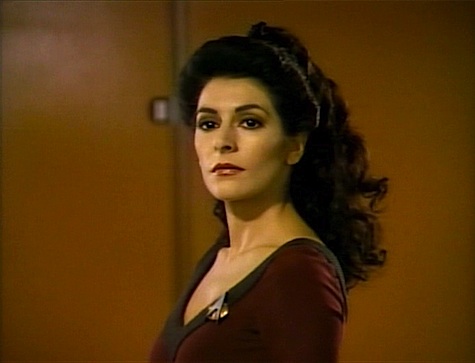
There is No Honor in Being Pummeled: Worf wants to assign a security detail to the Cardassian delegation, which Picard resists, but he does accede to his request to post guards at sensitive areas of the ship. This proves wise when Telle is caught with his fingers in the proverbial cookie jar.
No Sex, Please, We’re Starfleet: We see breakfast with the newly wedded O’Briens, as prepared by Keiko: kelp buds, plankton loaf, and sea berries. O’Brien is less than impressed (“I’m not a fish”), and offers to share some of his favorite foods with her, as she’s been doing with him, and makes her a potato casserole that evening (which she has equal trouble with—”What are these dark things?”). It plays as if this is the first time they’ve ever shared meals together, which makes you wonder what they did while they were dating. Their two scenes together feel more like early dates not long after they met, not their first week (or whatever) living together as husband and wife.
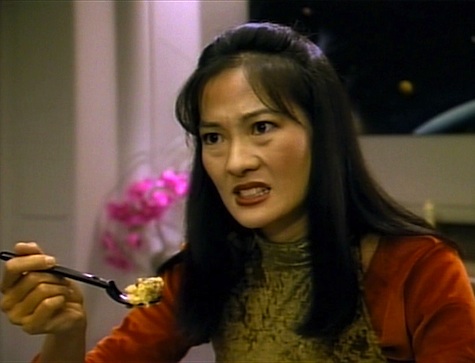
I Believe I Said That: “Benjamin Maxwell earned the loyalty of those who served with him. You know, in war, he was twice honored with the Federation’s highest citation for courage and valor, and if he could not find a role for himself in peace, we can pity him—but we shall not dismiss him.”
“You are welcome to your opinion, Captain. I, for one, am grateful that he is under lock and key.”
Picard and Macet discussing Maxwell, both making excellent points.
Welcome Aboard: Marc Alaimo makes his third appearance on TNG as Macet, having been an Antican in “Lonely Among Us” and a Romulan in “The Neutral Zone.” He’ll return as a 19th-century gambler in “Time’s Arrow Part 1,” and, of course, have a recurring role as another Cardassian, Gul Dukat, throughout Deep Space Nine.
Two other actors return, one in the same role—the late John Hancock as Admiral Haden, last seen in “The Defector“—and one as a new character—Marco Rodriguez, who played Captain Paul Rice in “The Arsenal of Freedom,” here playing Glinn Telle. Time Winters does quite well as Glinn Daro, particularly in the scene in Ten-Forward with O’Brien where they discuss Setlik III.
But the big guest here is Bob Gunton, one of the finer character actors alive, who makes Captain Maxwell far less of a caricature than he might be in the hands of a lesser talent. Probably best known for his roles in The Shawshank Redemption and on 24, Gunton currently has a recurring role as a retired general running for office on Royal Pains.
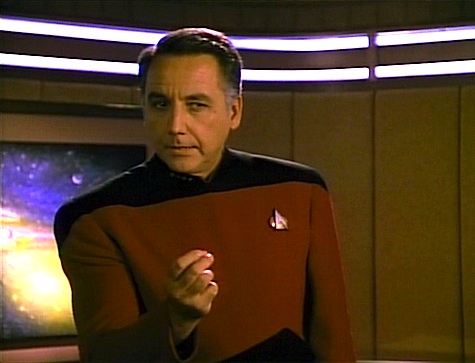
Trivial Matters: This episode introduces the Cardassians, a species that would become very important moving forward, central as they are to both Deep Space Nine and Voyager (more the former than the latter, though the Federation-Cardassian conflict is part of what sets in motion the events of Voyager‘s pilot episode).
The Setlik III massacre (and O’Brien’s participation in it) will continue to be referenced throughout DS9 (most notably in “Tribunal”), and be dramatized in the novella “The Slow Knife” by James Swallow in the Seven Deadly Sins anthology.
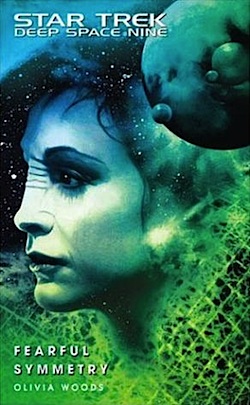
While this is the only time Macet is seen onscreen, he returns as a recurring character in the post-finale Deep Space Nine fiction, reintroduced in your humble rewatcher’s Demons of Air and Darkness and appearing in the Mission: Gamma miniseries, Unity by S.D. Perry, the Cardassia portion (written by Una McCormack) of Worlds of Deep Space Nine, and Fearful Symmetry by Olivia Woods. His resemblance to Dukat is given the in-universe explanation that they’re cousins (y’know, like The Patty Duke Show…), but he is a far more sympathetic character than the villainous Dukat.
This is the only time the brown Cardassian uniforms are seen—ditto the silly helmet Macet and the others are wearing when we first see them. The Cardassian uniform was redesigned later on to the more familiar gray uniforms seen on Deep Space Nine—including in flashbacks that predate “The Wounded.” The novel Fearful Symmetry explained that the brown uniforms were specifically for those assigned to the Federation border. (There’s no explanation for the helmet, but seriously, could there possibly be a good explanation for it?)
In addition to their development over the course of TNG and especially DS9, the Cardassian culture is also examined in depth in several novels, most notably A Stitch in Time by Andrew J. Robinson, The Never-Ending Sacrifice by Una McCormack, the three Terok Nor novels by James Swallow, S.D. Perry, and Britta Dennison, Fearful Symmetry by Olivia Woods, and your humble rewatcher’s The Art of the Impossible.
“The Minstrel Boy,” written by Thomas Moore in memory of his friends from Trinity College, Dublin who died in the Irish Rebellion of 1798, will be used again as the soundtrack music for one of O’Brien’s final scenes in the last DS9 episode “What You Leave Behind.”
Haden’s urging to Picard to keep the peace due to Starfleet’s inability to sustain a major conflict indicates that the fleet has not yet been rebuilt after the losses against the Borg in “The Best of Both Worlds Part II.” The depleted Starfleet will also be an issue in the season-spanning “Redemption” two-parter.
Speaking of “Redemption,” that episode will make use of O’Brien’s experience at tactical established here.
And speaking of the Borg attack in “The Best of Both Worlds Part II,” Maxwell specifically compliments Riker on his work against the Borg in that episode.
Make it So: “The minstrel boy to the war is gone.” This is an episode that is actually stronger upon rewatching because the Cardassians wound up becoming so important to 24th-century Trek—particularly to DS9, but also TNG and Voyager—that this episode has even greater resonance. With everything we learn about the Cardassians over the course of the next few years, Maxwell’s anger, O’Brien post-traumatic stress, and the Cardassians’ deception all feel even more compelling and convincing than it would have for a simple one-off alien empire we’ve never heard of before.
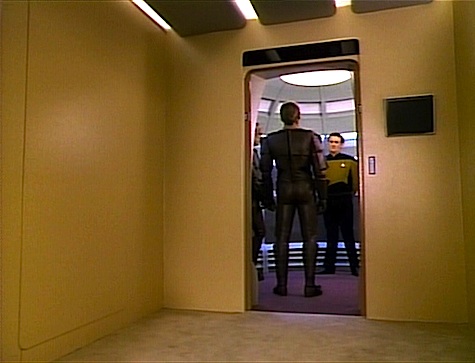
The episode also continues the expansion of the Miles O’Brien character, both in seeing his and Keiko’s new life together following their marriage in “Data’s Day,” and his past service on the Rutledge under Captain Maxwell, including fighting the Cardassians.
The Cardassians are also permitted to have depth. On the one hand, we have Telle to represent Cardassians who are less than honorable by trying to read things he shouldn’t on the computer. On the other, we have Daro and his conversation with O’Brien in Ten-Forward. And then there’s Macet. In the end, you don’t know if he’s truly as honorable as he seems when he tells Picard that he wants peace as much as Picard does, or if he’s complicit in the hiding of weapons. Or maybe both. Either way, though, his justified anger at Maxwell’s murder of almost 700 Cardassians is palpable.
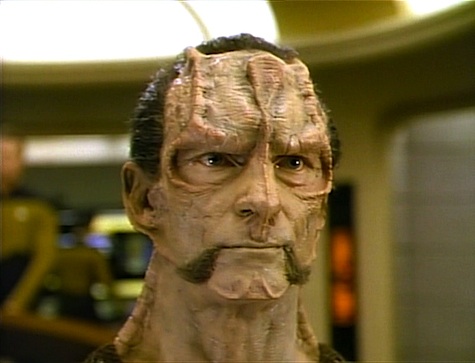
What makes the episode work most, though, is not so much the tension and the confusion and the attempts to deal with peace when you’ve gotten used to war—though that all works to some degree or other—it’s the magnificent scene in the ready room where Picard punctures the balloon of Maxwell’s macho self-righteousness. So often dramatic fiction portrays people like Maxwell as heroes, and I approve of a story in which he’s just a murdering thug. Even though Maxwell’s actually right, Picard firmly comes down on the side of the ends not justifying the means. Even O’Brien, who has trouble dealing with the Cardassians because of what he saw and did on Setlik III, knows that what Maxwell has done is wrong, pointing out the fallacy of falling for propaganda about your “war-mongering” enemies. Maxwell’s not a good person, and he deserves both the pity Picard gives him in the end, as well as Macet’s scorn.
A few things hold the episode back from being as good as it can be, and no, I’m not just talking about those awful helmets the Cardassians wore at the top of the episode. (Although, seriously, what the heck were they thinking????) First, there’s O’Brien’s remembering Setlik III, where he was escorting “women and children.” So there were no men left? What were they all doing? That just struck me as wrong, particularly in the allegedly egalitarian Federation.
Also, the peace treaty was only a year ago? So there was all this war before that, one so traumatic that it’s caused Maxwell to go all binky-bonkers? If so, well, where the heck was it during the first couple of seasons? Aside from the Borg invasion, there’s been no indication at any point on TNG that the Federation was in any kind of current armed conflict, so retconning this one strains credulity just a bit. (As a for-instance, shouldn’t it have been mentioned when Data was looking at Starfleet as a whole in “Conspiracy“?)
More fundamentally, though: where was Maxwell’s crew in all this? Their captain just committed mass murder on a major scale. If Picard did something like this, there would at least be a discussion of it—hell, the crew met to express concerns just when Picard was acting weird in “Allegiance.” But did Maxwell tell his officers that he was acting under orders? And if so, what did he tell them then the Enterprise showed up? Why did these guys all go along with the murder of 700 Cardassians?
I’m not saying it doesn’t make sense that they would go along with it, I’m saying that it’s a flaw in the story that they’re so completely absent. We don’t even see them on the Phoenix when Picard communicates with them or when O’Brien beams over.
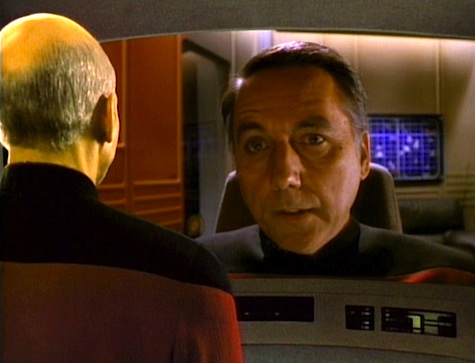
These are, admittedly, minor flaws, but they do stand out a bit, at least to me. Doesn’t mean this isn’t a good episode, though.
Warp factor rating: 7
Keith R.A. DeCandido is a guest at I-Con 31 at Stony Brook University this weekend, along with Star Trek actors Nana Visitor, J.G. Hertzler, and Casey Biggs (who played the Cardassian Damar), as well as fellow Star Trek novelists Peter David, Robert Greenberger, Glenn Hauman, John Peel, and Aaron Rosenberg. His schedule is here.










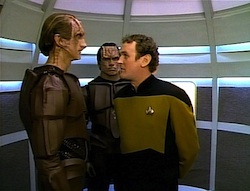
I too was always bothered by the retcon of a war we had never heard of up until this moment. Still, as you note, given what comes later, it ends up working okay.
— Michael A. Burstein
I always figured, that in regards to the war, it took place in the year or two before TNG’s first season. And that the Federation and the Cardassians had been working towards a peace treaty in the first 3 years of the show’s run. But even that’s probably stretching it.
I feel that this is the episode that won Colm Meaney a role on DS9, his tenor as a man who has gone through war and come out the other side alive but still hinting at having prejudices was pitch perfect for the types of characters that made up the DS9 crew. This also begins the “O’Brien must suffer” regimen (though Keiko cancelling the wedding could be something that predates it) when he has to be the one to talk down Maxwell and ruin the image that he had of one of the men he respected. It’s subtle, but there.
I did love this episode specifically for the introduction of the Cardassians, though. Alaimo was the most awesome choice to play that role, and done by anyone less, we may not have had what excellent villians we did in the Cardassians in DS9. Although, I always found Macet’s jowl ‘stache kind of wierd. Also, far to often do we get the “one world view” held by alien races, but with the compassion or at least friendliness shown by Daro here, we get an early picture that not all Cardassians are evil and conniving.
I think (taking into account all the logistical problems with the episode: I mean, seriously, where is his crew in all this?) that this is one of the better written episodes. It does justice not only to a new race in the Cardassians, but also gives an interesting take on interspecies relations and the real outcome of war.
As for the War We Never Saw, could it be that the fighting part of the war ended prior to TNG, but it just took the peace treaty negotiations that damn long to be signed and ratified? I don’t know how “The Lost Era” books handle it, but that is kinda explainable away. It’d have been better if someone had added a zero onto the end of that 1 in the script.
There’s one other significant Trek-lit tie-in to this episode — David R. George’s “The Embrace of Cold Architects” in the third Myriad Universes collection, where we see how this episode would’ve played out if Picard had died in BoBW.
The ret-con nature of the Cardassian War is annoying, but compared to ridge-headed Klingons, or the original Enterprise being under the United Earth Space Probe Agency, it’s nothing I’ll get worked up about, especially when it led to such excellent storylines in subsequent seasons and spinoffs.
Not really the best justification for the meals, but I think back to when the missus and I weren’t married – we would go out or we would make things that were a bit more fun or neutral. Mundane day-to-day food wasn’t something you bothered with, more out of a desire to better enjoy the time with each other than anything nefarious. Suddenly having do deal with the usual traditional meal after marriage might be a bit of a surprise (we’ve been married almost seven years, and I only found out last year that the missus like brussel sprouts).
Granted, with replicators making whatever you want, this should be less of an issue. After all, who would eat cheap Great Value brand marshmallow cereal when could can have expensive Lucky Charms?
I actually like the Cardassians’ helmets here. They fit together nicely with the makeup design. Yes, they’re weird-looking, but alien designs should be weird to the human eye. And maybe they’re functional. Maybe the Cardassian forehead thingy and nasal cartilage are comparatively fragile.
As for the retconned war, there are a couple of ways to rationalize this, and I’ve mentioned them in a couple of my tie-in novels. One is to borrow a notion from Poul Anderson’s SF universe: a large interstellar civilization would be so huge and complicated that it wouldn’t be one cohesive unit so much as a bunch of loosely connected, largely independent parts; so something major going on in one portion of it might have little or no impact on other portions. A war that seems massive to a few planets along the border could be a small skirmish on the scale of the whole vast civilization, and thus have no impact on Earth or on a Galaxy-class ship exploring on the other end of known space.
A simpler way is to remember that “war” can technically refer to the state of diplomatic/political relations between two nations; it’s possible for two nations to be officially at war without any actual combat taking place. For instance, North and South Korea have been in a declared state of war with one another for the past 62 years, but the only periods of active, ongoing conflict were 1950-53 and more intermittently along the DMZ from 1966-69, with occasional border tensions and skirmishes thereafter.
So the way I figure it is that the war with the Cardassians was a series of on-and-off border disputes in the 2350s to the early ’60s, that the last significant bout of fighting was sometime before 2364, and that a declared state of war with no actual combat continued for several years before a truce was negotiated in 2366.
As for the episode, it was cool for O’Brien to be given a major role at last, but this episode started a trend I wasn’t crazy about, a tendency to portay O’Brien as this brilliant guy with unparalleled skills, as Maxwell did here when talking about his past as a tactical officer. I felt it took away from his everyman qualities.
And to the person who chooses the photos: Next time Keiko shows up, could you please choose a picture of her that isn’t unflattering?
The retcon of that war is more than just inserting a specific conflict into the history; up until this point it was at the very least strongly implied that the Federation, and most of its neighbors had been utterly and completely at peace for decades (since the Fed/Klingon/Romulan dustup that Khitomer was part of, most likely.) There are parts of the Pilot’s trial that at the very least ring false, (if they aren’t uttery untrue) in the light of the Federation having just months ago having signed an uncertain cease-fire…it’s an even bigger departure from Rodenberry’s original concept for TNG than a present threat in the Borg. Probably for the good, but still…
@7: That’s where the Poul Anderson idea comes into play. While the conflict with the Cardassians may have been a major affair to those worlds right along the border, it would’ve been just a minor nuisance to an interstellar civilization as immense as the Federation, one encompassing hundreds of entire worlds. It wouldn’t have been big enough to affect the entire Federation, or even most of it, the way the Dominion War did. So on the whole, the civilization would’ve considered itself to be at peace.
Still, you’re right — it was a troubling and unfortunate retcon, and it shows how much the ideas behind the series changed between the first season and the later ones.
This is the only time the brown Cardassian uniforms are seen…
There is one other appearance, in season 5’s “Ensign Ro,” where Gul Dolak wears the brown outfit. I think you only see him from the shoulders up throughout that episode so it’s hardly noticeable. If I’m not mistaken, the black armor first appeared in DS9’s “Emissary” and in season 6 on TNG. I always took the whole conflict between the Cardassians and the Federation to have been a situation where hostilities took place a couple decades earlier, during Picard’s time aboard the Stargazer, as noted, and that they were functionally at peace for quite some time before TNG takes place. Rather, the negotiations for the final peace were incredibly protracted, so that the two sides were de facto at peace but de jure only in an armistice or even still at war, to the point that the Cardassians were not considered a major threat (unlike say, the Romulans) and enough time and events had passed for the war to be out of immediate memory. This seems evident when you consider just how long after this episode (by which time there a peace agreement has already been established) it took to complete negotiations establishing the DMZ and figuring who was going to cede star systems to whom, when those negotiations probably began with the end of the war. The Cardassians are later portrayed as being incredibly difficult to negotiate with on a good day. Of course that is all just my opinion and means of justifying how a major war could have taken place that we had never heard of before now. That said, the Cardassian conflict is a lot easier to accept, given what we know, than some of the other random and supposedly major conflicts that we are told of over the course of Trek but never saw evidence of (the Tzenkethi War comes to mind)…
As for the episode itself, I applaud it for being one of the few to take a chance at focusing on a non-regular. Some may argue whether or not O’Brien can come close to being considered a regular on TNG, but still it was very unusual for a character not mentioned in the opening credits to get this level of attention on TNG, the only one I can think of up to this point in the series being Lwaxanna Troi. This episode would have had almost no credibility if they had tried to give the Setlik III backstory to Geordi, or Riker, or Worf. Even if the actors could have made it believable, shoehorning a backstory of this magnitude into their characters after having gone four seasons without ever hearing it would have made it completely unbelievable (and it’s hard enough to reconcile the Cardassian war as it is). Several of the episodes where a minor or recurring character took center stage (like those about Ro Laren, or “Lower Decks”) were very good and I think it’s too bad that it didn’t happen more often over the course of the series.
Is anyone else bothered by the fact that it seems whenever the Federation signs a treaty with one of their enemies, the other side seems to violate it with impunity? Both here and later with the Cardassians. All those episodes where the Romulans are obviously up to no good along the neutral zone. Some of it I suppose can be justified by other goals (like here where the Federation simply cannot afford to go to war no matter what the provocation), but it really feels like Starfleet should just hang out a sign, “Welcome to the Federation, Doormat of the Alpha Quadrant.”
Colm Meaney plays an absolute blinder in this one, and Marc Alaimo and Bob Gunton are also right up there. I take Krad’s point that this episode needs a fair old bit of retconning – and if there’s one thing I always struggle with, it’s the ease with which the Enterprise disables Macet’s ship at the beginning – but it doesn’t change my conviction that this is one of the finest episodes of the entire franchise.
I think one might perhaps give Picard’s speech in the transporter room an honourable mention for the ‘I Believe I Said That’ section. IIRC:
‘I think that when one has been angry for a long time, one gets used to it. Then it becomes comfortable, like… like old leather. Until finally… it becomes so familiar that one cannot remember feeling any other way.’
@7 and @10 –
I was watching this with my husband and I said the same thing – for a so-called enlightened 24th century that was Gene Roddenberry’s vision, there sure seems to be a lot of conflict/war with shifty, duplicitious parties. Or is it just humans that are that awesome?
That aside, I did think it was a very good and interesting episode, especially regarding the ends-justifies-the-means philosophy, and viewing your enemy as inherently warmongering. On one hand, I was thinking, “Well, the Cardiassians clearly ARE the villains – after all, they killed women and children!”…but humans have done the same, and in the Trek universe they overcame that, so perhaps one day the Cardassians could too. Although it is a little irksome that species like the Cardiassians and Romulans are almost always portrayed as devious.
When Maxwell first beamed aboard I couldn’t make out his face (bad eyesight)…but when he spoke I laughed and said, “Hey, it’s the warden!”…AND THEN IT TOTALLY WAS! It actually colored my view of him a little…it was hard not to see him as kind of slimy.
Oh, and krad – thank you for mentioning the Warp 9 thing! When he said to go to Warp 9 my jaw just kind of dropped. I had assumed the entire time they would be going faster than Warp freaking 4!!
@6–I think that’s a pretty good explanation of the war. I was thinking something along those same lines…maybe it’s not an all out “war”, but maybe a conflict with a series of border skirmishes, but the Federation is ultimately trying to make/keep a fragile peace so they don’t commit all their resources to the conflict. Because the other problem I have with this is that there are several occassions in this episode that mention the the Federation has superior technology (and I think this is confirmed later on Star Trek), and certainly both the Enterprise and the Phoenix can whoop even the warships they go up against. Granted, those are some of the most advanced ships in the fleet, but still. I never got the impression that the Cardassians were necessarily overwhelming in number (though I haven’t seen enough DS9), so I wonder how the Federation wouldn’t have the upper hand in an all-out conflict.
But in general, I think we see that as time goes on, Star Trek–and more specifically, the Federation–get more and more away from what Gene Roddenberry had in mind. Season 1, while somewhat bad in terms of quality, had more ideas that were inline with what Gene thought Star Trek should be, in my opinion.
@5: They would of course eat Lucky Charms as much as they could, but would they be as good? When Troi tries to order a real chocolate sundae in “The Price”, the computer says that the foods are perfectly balanced in regards to nutrition. Granted, General Mills has been going all whole grain…
Excellent episode on so many levels. Most of the finer points have already been mentioned above, so I’ll just add that this episode has the distinction of introducing a very cool starship design in the Nebula-Class U.S.S. Phoenix.
I’ll never understand why they retcon things like this? Why did the end of the war have to be so recent? The Cardassians are being suspected of re-arming. So, why could’t it be 10 years later. Like Germany after WWI, for instance. Heck Picard even spoke about being in a conflict with Cardassians while he was captain of the Stargazer, which means it had to be at least 15 years prior to this episode.
Did they or did they not have people paid to check scripts for continuity errors?
Otherwise, yes, this is a terrific episode, introducing the Cardassians and adding a great deal of depth to the character of O’Brien which would inform Colm Meaney’s performance throught DS9. Speaking of O’Brien I remember after watching this episode for the first time that I thought O’Brien should be the new regular character to replace Wesley. Alas it wasn’t to be, but what we got from him on DS9 was even better…
Watching this episode recently (a couple of weeks ago), I sort of saw the Cardassians as a stand-in for the Soviets, not necessarily because of out-and-out conflict but because I could see an American sub captain losing it and taking out Russian ships feeling like the Cold War was still going on. I checked the date of release (1/91) and then did a quick google search and saw that the USSR was formally liquidated less than a year later. Just a random “whoa” for me, I guess.
This is a good example of how you *should* introduce a new race, as opposed to the introduction of the Ferengi. The Cardassians come across as believable opponents and multi-faceted. Some of them are noble, some are duplicitous, some evil.. but you don’t automatically hate them. Too many Star Trek races are one-dimensional (Ferengi- Greedy, Romulans- Duplicitous, Klingons- Warriors) but you get an inkling here (and really get a better one in DS9) that the Cardassians are a tough race in a tough situation.
As far as the war goes, I agree with Chris Bennet- in an organization as large as Starfleet, you’d imagine a couple of sector fleets might be involved, but much of the fleet is off doing something else. For example, during Vietnam the Pacific Fleet would have a few carrier battle groups at Yankee Station off the coast of Vietnam, but the rest of the PacFleet and the entire Atlantic Fleet would not be in combat operations. Ships might rotate in and out of the area, but at any given time, much of the fleet is not fighting anyone.
Of course this leads to a glaring inconsistency- exactly how big is Starfleet? We are told that Wolf 359 is a grievous loss, but are 40 ships really that much of a percentage of the fleet? By the retaking of DS9 we have neitre wings of cruisers flying about and in the Destiny Trilogy we have hundreds of ships in the Azure Nebula and hundreds more at every major star system. I get the feeling that in TOS and early-TNG they saw the fleet as a relatively small force (say a hundred major ships) but they realized by the time they got to later TNG/DS9 that it really had to be much larger than that just because of a) how big space is and b) how many other races are out there.
I also need to agree with CLB on one other point- O’Brien is given the mantle of engineering know it all a la Scotty or Geordi who also happens to be awesome Tactical officer a la Worf. He can lead ground assaults, and put a transporter beam through a shield? Not bad for an enlisted guy who is probably in his mid 30’s. I can’t imagine enlisted personnel get to jump around such different tracks like he apparently did.
Lastly, two comments about the end of the episode. First, does the 1/50th of a second window seem like a writer mis-used the transporter because they had put themselves in a corner? Sort of a “we need to get O’Brien on board, but the shields are up… umm what if the shields go down automatically every five minutes for less time than it takes to blink?” Also, there have been several comments about where are the crew? I sort of took the idea that O’Brien is able to walk into the Captains ready room as a sign that the crew of the Phoenix is as ill at ease as we think they should be. The Captain that they’ve trusted and fought against says they need to do this- he’s put together a decent case (Picard pretty much tells Macet that he knows Maxwell isn’t wrong) but they don’t much like it. So when O’Brien beams onto the Phoenix, the crew who could have done pretty much anything to stop him… just let him walk up to the Captain and talk to him. As if they were saying “Maybe you can get through to him.” It makes for a great, great scene though.
@18, one of the reasons the fleets got larger as the series’ went on is because they were less expensive to produce. By the end of DS9 they required fewer and fewer models and had ginormous CGI battle sequences. By the end of Voyager they had vast Borg interstellar hubs and thousands of cubes. But your point is well taken that the loss of 40 starships should be a drop in the bucket for an organization as large as Starfleet.
@18: Since DS9 later introduced the concept that Starfleet has multiple numbered “fleets” (like the Sixth Fleet, Ninth Fleet, whatever), I tend to figure that “the fleet” that was so badly diminished by the loss of 39 ships at Wolf 359 was just the core fleet that protected the UFP’s own territory, while there were multiple other fleets out patrolling the frontier and exploring strange new worlds, fleets that couldn’t have gotten to Sector 001 in less than a couple of weeks and thus couldn’t have made a difference. Whereas with the Dominion War, which dragged on for a couple of years, the UFP had time to assemble all those disparate fleets into a unified fighting force to defend the core worlds. (Also, they probably really ramped up their shipbuilding efforts after Wolf 359, due to the growing threats from the Romulans and Borg.)
I could have sworn they said the peace treaty was signed 10 years ago…
Also, surely Transporter Chief is a significant demotion from an excellent tactical officer? Maybe he just really fancied a career change, or would do anything to get on the Enterprise.
euphbass: Nope, it was two years. Really. And since O’Brien was a specialist/enlisted guy, he goes where he’s told. *shrug* It’s a little odd, but no odder than a lot of other things we see on Trek. :)
—Keith R.A. DeCandido
That potato casserole raised far too many questions for me: Is a potato casserole like a potato salad? Is it common to use capers in potato casserole? How does Keiko not know what a caper is? Should I try combining capers and potatoes in my dinner preparations this week? Is there a Mrs. O’Brien “Irish Traditions, Final Frontiers” cookbook?
I don’t know why this kept distracting me during a really superb episode that introduces perhaps my favorite Trek species. I guess I find Trek food politics/attitudes utterly fascinating.
Absolutely wonderful episode. I give this one a 9. I love this on re-watch. This is the kind of episode I wish so bad they did more of. So complex, so rich, so important, and fun to watch. I really think the producers made a mistake going into the future by focusing on the Bajorans so much MORE than the Cardassians. I get it, the Bajorans were opressed, they were the Palestianians of the 24th century. Sorry to the Bajoran lovers, but for me, that was intriguing for about 3 episodes, NOT an entire series.
I have only one problem with this episode. And it is reflected in Krads comment here: “Why did these guys all go along with the murder of 700 Cardassians?” I will answer your question: Maybe because the Cardassians are arming for war. Again, I am probably the least liberal person that posts here, and I realize Star Trek is a very liberal show, but sometimes it stretches credulity. You guys are telling me that the cardassians are arming for war, attacking federation ships and colonies, so Maxwell attacks some of these ships illegally transporting weapons, and Picard stops him, AND MAXWELL GETS LOCKED UP????
I mean, seriously, let’s take our Picard blinders off here for a second. Most of the commenters here (including Krad) ADMIT Maxwell was right. Maybe I am a right-wing militant baffoon here, but last time I checked, when someone is right, they are NOT WRONG.
@6, good point, I was just going to mention North-South Korea as an anaology of the federation and Cardassians. That being said, I do agree with poster #7, that to have a border war is not very roddenberrian, and I think he would have hated this concept, as I am sure he would have hated ALOT of DS9.
@10, “Welcome to the federation, doormat of the Alpha Quadrant”, exactly my point.
@14, I agree, although Season 1 was somewhat bad, I will always have a soft-spot for it. Gene really believed humans would evolve, and I think that served star trek up to season 3 of TNG well. I really am on board with those who thinks Gene would have hated DS9. Now, I will say, I love DS9. BUT, I think it is safe to say DS9 is NOT true Star Trek.
Actually, Cap’n Max is presented as something between “just a murdering thug” and a hero, which is why this is a good episode- because it comes close to the more complex shadings of DS9, wheras TNG often ended up as Mushy Liberal Pap of THE FUTURE.
There is nothing in this episode to suggest that the Cardassians are attacking Federation ships and colonies. Yes, they established and were arming a covert military station, which is undoubtedly bad news (it may or may not be a violation of the treaty, the episode doesn’t say). But unless Maxwell had some reason to believe that an attack was imminent–and he never says that he did, even when he’s trying to justify his actions to Picard–his job was to give that information to his superiors, not to unilaterally start a war. I don’t see anything particularly shocking about court-martialing an officer who commits acts of war based on suspicions he hadn’t tried to convey to his superiors–before or after he did it–because he thinks they’re stupid. It’s my understanding that militaries generally frown on that sort of thing.
So I have been rewatching STNG on my own, and making my wife watch it somewhat begrudlingly for her first time, and coincidentally came upon this blog. I have been following Keith’s writings and the commentary, and never felt compelled to write until this episode. I think most of you missed the point and context of this episode. You have completely taken it in the context of where Starfleet was at in this day in history, and gotten caught in the semantics too much to recognize a truly excellent piece of television. First off, Keith and the commenters outrage over not knowing about a Starfleet-Cardassian war is misplaced. A war against a technologically inferior opponent would require significant resources as far as personell, but realistically would not be a threat to the federation. Imagine a scenario like the Iran-Contra afare. The Federation would certainly have troops and resources allocated, but the day to day lives of the rest of the federation would not be impacted. If you picture starfleet as hundreds of worlds, it makes sense that small scale wars wouldn’t be the subject of everday concerns. Secondly, everything else aside, I loved and remembered this episode because it humanized Starfleet! What a great accomplishment! They’re not just people flying around making everything perfect, sometimes terrible things happen and yet as a whole they’ve chosen to commit to a greater cause. It defines Roddenbury’s dream, and Picards choices reenforce that message. And as a final note, this whole episode just makes so much sense when looking at what Starfleet had been through! Forget exact numbers, a whole bunch of ships had beeen destroyed. They were drastically reduced in power. A war with even an inferior opponent was to be avoided at all cost, and Picard was called in to ensure that happened.
jplsquared: The issue at hand wasn’t whether Maxwell was right or wrong. The issue is that his methods were unjustified.
We know al-Qaida terrorists are bad people, and what they are doing is wrong, but we don’t rip people’s fingernails out and push hot pins through their eyes to get intelligence about them.
I know I`m way late in the game on this thread, but I wanted to clear up the question regarding why Picard chose to travel at Warp 4 when attempting to intercept the Pheonix. First, traveling at maximum warp can only be sustained for a period of 24 hours before the warp core overheats. Admittedly, I cannot reference what episode this information came from, but I`m fairly certain the comment was made by Laforge in Engineering during the first or second season. Second, Warp 9 isn`t a speed that is commonely used by the Enterprise unless they`re in iminent danger, or they are in dire need of getting somewhere before some disaster occurs. If you`ll think back to the episode, Riker informs Macet that they haven`t the slightest inkling where the Pheonix might be at this point, although he rightly postulates that their last known location would be the most logical place to start. Since the location of the Pheonix is technically unkown, and the damage to the faux Cardassian Science Station already inflicted, there would be no point in pushing the Ship`s engines at maximum warp. It is, by all formal logic, better to proceed at a steady pace (although Warp 4 is pretty damn fast, people) at only increase to 9 in the event of an iminent crises which, albeit too late late, Picard does.
From somewhere just prior to this episode throughout the rest of everything Star Trek, and in particular, Voyager, too many episodes are plagued by two things: a technobabble problem/solution, and the obligatorily manufactured countdown that is averted just prior to disaster. This very good episode is plagued by neither of these unfortunate plot devices, and therefore, it automotically earns a warp factor two upgrade. Warp nine. Too bad there isn’t a hot babe guest star, or, the immutable laws of physics aside, we might have gotten past warp ten.
Historical note: this episode debuted in the middle of the first Persian Gulf War. I’m sure it was filmed before the war began, but I wonder if all the rhetoric in the runup to the war (which lasted far longer than the war itself) influenced TNG into doing a “wounded warrior” episode.
I’ve always liked this episode for the fleshing out of O’Brien and the introduction of the Cardassians, who are one of my favorite species b/c they’re complex, they also graduated top-of-the-class like Picard (as I think Ron Moore once said) and as they are developed in later episodes, can be sinister as hell (“the Nazis of the galaxy”). The Cardassian War not being mentioned could be considered a continuity issue but I see it differently. The Federation as Picard says in “Star Trek: First Contact” is 8,000 light years and has over 150 members. That is a vast territory. Sectors have been established as being 20 light years and seem to require at a minimum several hours to traverse (though of course always subject to the speed of plot). So even with the concept of a “small Federation” as theorized during the Dominion War, it would take several years to cross all of the Federation’s territory. If the Enterprise was exploring one end of the quadrant, it could still be in line with continuity that the Federation-Cardassian War wasn’t mentioned b/c it took place on the other edge of Federation space. I also always got the impression from the DS9 episodes, that the Cardassians (and Bajorans) considered the war and Occupation of Bajor to be a much bigger deal than the Federation. In “Ensign Ro”, Picard stated that in regards to the Cardassian atrocities on Bajor, that “We were saddened by those events but they occurred within the borders of the Cardassian Empire”. To me that means that the Federation obviously knew about the annexation of Bajor, thought it was deplorable, but they had other priorities: the Klingons, the Ferengi. What to the Cardassians was a “war”, to the Federation may have been a series of skirmishes and raids on the outer edges of their space.
I loved this episode, for all of it’s O’Brien development (despite making him a Tac genius as well as an engineering one), and for introducing the Cardassians.
@24 – jlpsquared: I come into this almost three years after your post, and nine months after the last one here, but still. I have to point out that if you believe the Bajorans are the Palestinians of the 24th century, you either do not understand the Palestinian situation, or you haven’t paid attention to the stuff said and shown about the Cardassian ocupation of Bajor.
I know I’m really late to this thread but I’m a slow reader but I must comment on this. Krad I must correct you on one of your trivial matters: massacre of Setlik III was first dramatized in the novelisation of the pilot episode of DS9. The DS9 numbered novel #1 Emissary described the battle in detail during an O’Brien dream sequence. Whether this scene was in the original teleplay and cut from the final episode I’m not sure. It’s worth a read.
KRAD, when you’re quoting the Picard/Maxwell scene, there’s some dialogue not in the finished episode (I did what had to be done/what had to be done). Is that from the extended cut of The Wounded because it’s not in the script?
David Sim: I have no idea what you’re talking about. The dialogue I quoted was all from the episode as aired, and as on the DVD.
—Keith R.A. DeCandido
Were there any plans right away to make the Cardassians recurring antagonists or was it because of the above-average portrayal here that the show (and DS9) came back to them?
I rather like the sequence where Enterprise monitors Phoenix destroying the Cardassian ships. I don’t know if avoiding the costs of a full effects sequence was a motivation but the starkness and detachment of the representation of the deaths of so many is good for the drama.
Phoenix has such an easy time destroying the Cardassian ship, though, that I wonder why the Federation fears war with these people. The same is true of Enterprise‘s scuffle with Macet at the beginning of the episode. Picard doesn’t even seem worried.
@38, I believe it was the Cardassians’ second appearance and the Bajorans’ first appearance in the same 5th season episode, “Ensign Ro”, that solidified the Cardasssians as the go-to baddie to be used on DS9.
Maybe Picard doesn’t fear the Cardassian ship because the Enterprise so greatly outclasses it. Perhaps the Cardassian ships are really only effective with multiple numbers which is often how we saw them presented on DS9.
I really enjoyed this episode. Yes, the flaws our rewatcher has pointed out are present and they are what keeps the episode from becoming a truly great episode. Especially the parts about how ‘women and children’ where threatendor even killed. So, would it have been better if only males would have been killed? ‘1000 dead, luckily all of them where male!’ yeah, that doesn’t really sound right, does it?
But I like how the Cardassians are presented here. They are not one dimensional as other alien races but all three of them are distinctive characters, thoughts and goals. Also Maxwell isn’t the gone mad captain that he appears to be during the beginning. In the end he even was right with all his accusations.
The Cardassians made for good adversaries. You had good and bad people on the other side, just as in real life. Bob Gunton gives a definitive portrayal of a man who’s been on the front lines and knows his foe. The Federation’s attempts to avoid war through Picard will of course come back to haunt them in DS9, as would O’Brien’s attitudes towards the Cardassians.
A very good episode that I always like to come to back to rewatching for a number of reasons: the magnificent introduction of the Cardassians (their makeup design, ship design, history of antagonism with the Federation, and portrayal by the actors), the always relevant and timely story of the traumatic and lingering effects on soldiers post-war, and so many excellent performances, from the various actors portraying the Cardassians, to the always reliable Patrick Stewart, to an outstanding guest lead by Bob Gunton, to a revelatory performance by Colm Meaney. This episode was basically the audition for Meaney for his main cast role on DS9. Same goes for Marc Alaimo on his placement on DS9 as thee main villain on that series.
I find this original costume of the Cardassians with dorky helmets to be a fun look on a design that didn’t pan out. The redesign was so much better.
The writers really should have changed the line about the peace treaty occurring a year ago to four years ago so it wouldn’t conflict with not seeing a war going on in the series in the prior three seasons.
And yes, it is a bit weird that you never really hear from or see any other officers on the Phoenix, and you’d have to imagine some would object and mutiny for his actions. It’s easier to imagine that Maxwell somehow commandeered the ship on his own as unpractical as that sounds. Of course the practical reasons we never see any officers on the Phoenix is that the episode already had a pretty big guest cast, I counted 7.
You’ll also note in this episode reoccurring extra and Brent Spiner photo double, Guy Vardaman’s prominent placement in the teaser. In the very first scene you have the viewer perspective of looking into the bridge set facing the captain’s chair with Vardaman on the viewer’s left in red uniform at conn and Spiner at ops in his gold uniform. They practically look like twins and you can see why Guy was Brent’s photo double. Fun fact, early in TNG’s run Guy was often mistaken for Brent by some of the crew which led to him being given the position of Brent’s photo double.
Oh, and Keiko’s breakfast meal for herself and O’Brien looks and sounds delicious! As someone not big into red meat or “heavy” meals, I can relate to her culinary preferences!
Re: the ease of the barratry with the Phoenix
I suppose cult of personality is at play. As long as Maxwell can get the senior officers onside, then he has effectively secured the ship. The junior officers are likely not to challenge their/his orders, especially if he implies he has some form of Starfleet blessing. Any dissenters can be confined to quarters, which is the same offer Picard makes in First Contact [I think] when he defies orders to take the Enterprise to Earth from the Neutral Zone. And again when they commit Insurrection a movie later.
As tight knit independent units, Starships must be uniquely vulnerable to that sort of subversion. Especially since Starfleet allows officers to remain in place indefinitely if they want to. That is one of the reasons Real Life militaries, even in Western Democracies, rotate officers through different postings; to prevent cult of personalities and little self interested cliques forming, and thus decrease risk of coups.
I suppose cult of personality is at play. As long as Maxwell can get the senior officers onside, then he has effectively secured the ship. The junior officers are likely not to challenge their/his orders, especially if he implies he has some form of Starfleet blessing. Any dissenters can be confined to quarters, which is the same offer Picard makes in First Contact [I think] when he defies orders to take the Enterprise to Earth from the Neutral Zone. And again when they commit Insurrection a movie later.
Jeffrey Lang’s DS9 novel Force of Motion actually addressed this (since Maxwell’s part of the book’s cast and so there are flashbacks to this episode).
It’s been a while since the I read the book, but IIRC, Maxwell did indeed imply the mission was Starfleet sanctioned.
However, Maxwell’s XO (and by implication the rest of the Phoenix Senior Staff) gradually began developing suspicions but they were also fiercely loyal to their skipper and they ignored the warnings signs.
By the time realized the truth, of course, it was too late. It added to the tragedy of “The Wounded” and Maxwell’s downfall irrepabably damaging or destroying many promising careers.
@43/garreth: “The writers really should have changed the line about the peace treaty occurring a year ago to four years ago so it wouldn’t conflict with not seeing a war going on in the series in the prior three seasons.”
Considerably longer than that, though, because it wasn’t just the lack of a war, it was the lack of the very concept that Starfleet needed to be prepared for war. As discussed earlier in the thread, early TNG portrayed a Federation that had been at peace for a long time. In “Peak Performance,” Picard — one of Starfleet’s most accomplished veteran captains — denied that Starfleet was even military (an incorrect use of the word) and found war games to be a pointless waste of time. That’s not the attitude you’d expect just two years after a major war ended.
The only real options are the ones proposed above: Either the Cardassian “war” was a border skirmish that had no impact on the majority of the vast Federation, or it was a declared war in the political sense with no actual fighting for decades, like the state of war that still technically exists between the US and North Korea. My preference is that it was both. It can’t have been that long ago, given O’Brien’s experience with it, and Jeri Taylor’s novel Mosaic established that it was still going on in the 2350s. So that calls for the “limited border conflict” option. IIRC, I established in The Buried Age that the open fighting had died down by about 2360 or so.
This episode is one of my favorites ever and it deserves a 9 or 10, not a 7. Star Trek has never done a good job of portraying how massive and spread out the Federation is. I’ll put it this way (albeit imperfectly, this may work better with two different nations)-a riot in California is unlikely to physically affect Massachusetts given the sheer physical distance. Multiply that by cosmic proportions. A war could be going on one side of the Federation while there’s generally peace on the other. We also don’t get enough back story. It could be that it’s been a cold war for X years. As far as Captain Maxwell’s crew, that could have been an interesting “C” story-but the story has to revolve around the Cardassians, the bridge crew, Chief O’Brien, and Captain Maxwell. That’s a lot to tie together-the crew might overburden or overload. It’s also entirely possible also that Captain Maxwell fed the crew disinformation.
I also am find myself disconcerted at your suggestion that Captain Maxwell could go “all binky-bonkers” so lightly. Trauma, even if it does not stem from war can sit very close to the surface and hurt all over again easily. I speak from experience here. Whatever caused Captain Maxwell to start reliving his war trauma is not elucidated in the clearest way and may have deserved some more explanation. But the suggestion that Captain Maxwell would suddenly go “all binky-bonkers” is at best, understating what he’s been through, and at worst, an outright insult to him. Indeed, Captain Picard seems solicitous of what Captain Maxwell has lived through.
As far as the women and children go, that might have been sloppy writing at worst. The writers were trying to give some sort of relatable context to the viewer that Chief O’Brien truly saw brutality in that the Cardassians would ambush the most ostensibly vulnerable (at least, vulnerable to those who had most recently fought in a war or historically considered vulnerable.) If Chief O’Brien said, “We were all men escorting women and children”-that’s problematic by 20th, 21st and 24th century standards. But he did not. For all we know, women fought on Setlik III, or were field physicians, etc.
I think you’ve read too much into the flaws here.
Revisiting this episode after starting DS9. It’s quite good! I love the departure from the One World Culture/stereotypes we often see in Trek.
I always am a little baffled by O’Brien’s attitude here when he tells Keiko he has no problem with the Cardassians and doesn’t understand why people are still upset about the war…right after yelling at them in the turbolift. Generously I suppose you could say this dissonance and Keiko’s skepticism helps him remember what his problem actually is and why he’s reacting this way but it strikes me as awfully lacking in self awareness. Maybe just clumsy writing in an otherwise nicely nuanced episode.
@48: I didn’t have any issue with that scene between Miles and Keiko because it showed his state of denial to the audience after his prior behavior with the Cardassians in the turbolift. Miles is also a reflection for Maxwell giving an insight into the latter man as both are suffering from the same prejudice and PTSD. So rather I see that scene you refer to as “clumsy” as insightful and integral.
Occasionally I will see blustery comments to these rewatches raging about what a wussy Picard is for his usual default to gestures of trust and goodwill when faced with a wary or suspicious adversary. Typically I disagree with those people, who seem to lament that the Enterprise’s mission is not to bully its way through the galaxy kicking alien ass.
In this case, though I have to be that guy. At the beginning, Picard is regaling the bridge crew with a story about an encounter with the Cardassians on the Stargazer, where he gave them the benefit of the doubt and they made him pay for it. And we learn that the Federation just ended a bloody war with them. Yet not only does he allow three of them onboard to serve as “observers”, it takes Worf and Riker to gang up on him and convince him not to give them free run of the ship.
Because y’know,, there is no precedent for guests taking advantage of being left unsupervised on the Enterprise. >rolleyes<
Now, having said all that, his steely-eyed warning to the Cardassian at the very end pretty much redeems him completely.
If you look real close at the facial expressions of Macet and Telle during the scene where Worf drags Telle to bridge to tell on him, you can see that Macet put Telle up to trying to access the computer and get caught so that Macet could give the impression that he was into working together with Picard. Telle is worried whether he did ok, and Macet lets him know that he is satisfied with his performance. The Cardassians’ putting on this kind of show would be seen again in DS9’s “Wrongs Darker Than Death or Night”.
I don’t agree that Maxwell is “not a good person” I see him more of a tragic character than a thug. He lost his family to the Cardassians and couldn’t deal with it. But O’Brien talked about how great of a captain Maxwell was. So Maxwell must’ve been a man of ideals at some point.
Now, I’m not one of those people who feel Maxwell should’ve been given a pass because he was right. What he did was definitely wrong and deserves to be punished for it. While I agree he’s not a hero, I don’t think he should be villainized either. I see him more broken than anything.
Oh, and I agree about the crew of the Rutledge. Picard practically acted like Maxwell was on the ship by himself. “We’ll have to tow you do the nearest Starbase.”
The fact that we’d be watching these episodes in hi-def on large, hi-res screens obviously wasn’t taken into account back when they were filmed, but it’s been distracting to me how many close-ups reveal stray, unkempt hairs, on the fastidious Picard’s head especially. (No particular reason this got mentioned now other than perhaps a larger-than-usual number of such moments reaching critical mass for me…)
“It plays as if this is the first time [Miles & Keiko] ever shared meals together, which makes you wonder what they did while they were dating.”
Yeah.
@21/22: it’s eventually established (or at least heavily implied) that O’Brien switched to engineering because he didn’t want to be a soldier/tactical guy anymore. It’s a pretty central part of his character, including in this episode, that he hated what being a soldier had done to him and never wanted to be one again.
@48: O’Brien knows he harbors racist feelings toward Cardassians and he’s ashamed of those feelings. He knows they’re wrong, and he doesn’t want Keiko to know he has them, but he wants her to help him move beyond them. It’s subtly one of the most honest and true-to-life Trek scenes of all time, because it is such a perfect reproduction of how a man in his position begins to try and work on himself.